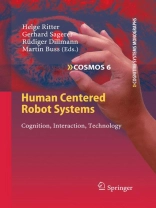Human Centered Robotic Systems must be able to interact with humans such that the burden of adaptation lies with the machine and not with the human. This book collates a set of prominent papers presented during a two-day conference on ‘Human Centered Robotic Systems’ held on November 19-20, 2009, in Bielefeld University, Germany. The aim of the conference was to bring together researchers from the areas of robotics, computer science, psychology, linguistics, and biology who are all focusing on a shared goal of cognitive interaction. A survey of recent approaches, the current state-of-the-art, and possible future directions in this interdisciplinary field is presented. It provides practitioners and scientists with an up-to-date introduction to this dynamic field, with methods and solutions that are likely to significantly impact on our future lives.
قائمة المحتويات
System Integration Supporting Evolutionary Development and Design.- Direct Control of an Active Tactile Sensor Using Echo State Networks.- Dynamic Potential Fields for Dexterous Tactile Exploration.- Unlimited Workspace – Coupling a Mobile Haptic Interface with a Mobile Teleoperator.- An Architecture for Real-Time Control in Multi-robot Systems.- Shared-Control Paradigms in Multi-Operator-Single-Robot Teleoperation.- Assessment of a Tangible User Interface for an Affordable Humanoid Robot.- A Cognitively Motivated Route-Interface for Mobile Robot Navigation.- With a Flick of the Eye: Assessing Gaze-Controlled Human-Computer Interaction.- Integrating Inhomogeneous Processing and Proto-object Formation in a Computational Model of Visual Attention.- Dimensionality Reduction in HRTF by Using Multiway Array Analysis.- Multimodal Laughter Detection in Natural Discourses.- Classifier Fusion Applied to Facial Expression Recognition: An Experimental Comparison.- Impact of Video Source Coding on the Performance of Stereo Matching.- 3D Action Recognition in an Industrial Environment.- Investigating Human-Human Approach and Hand-Over.- Modeling of Biomechanical Parameters Based on LTM Structures.- Towards Meaningful Robot Gesture.- Virtual Partner for a Haptic Interaction Task.- Social Motorics – Towards an Embodied Basis of Social Human-Robot Interaction.- Spatio-Temporal Situated Interaction in Ambient Assisted Living.












